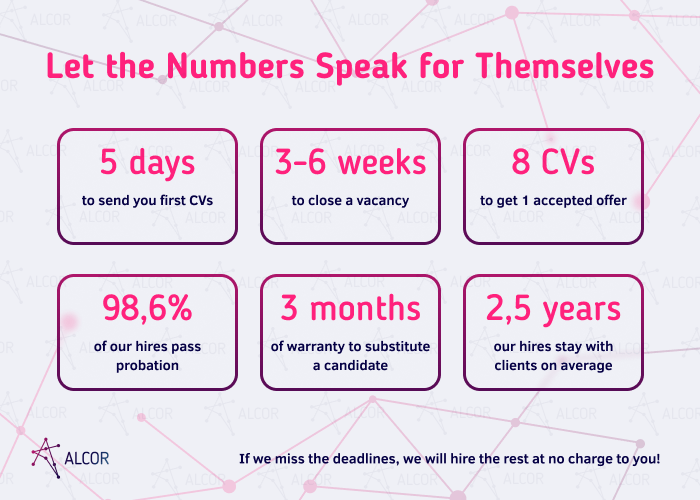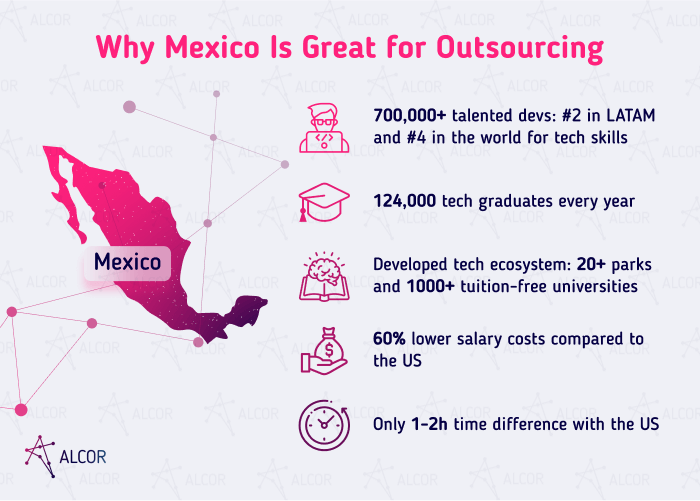The software development market in Mexico is on fire — it’s predicted to hit a whopping US$4.16 billion in 2024, and there are no signs of slowing down after that. One of the main reasons the Mexican tech industry is brimming with potential is because trends like booming cloud, AI and ML, Fintech, cybersecurity, and others drive it.
I’m David Gomez, Lead IT Recruiter at Alcor, a full-cycle provider of IT recruitment and R&D center services. For over 7 years of IT recruiting in Mexico and other Latin American countries, I’ve gained valuable experience and insights into its tech and know the best practices to help product IT companies set up their top-tier software engineering teams from 0 to 100 employees within a year.

In this article, we’ll delve into the latest trends in the Mexican software development industry, overview of the local IT industry, tech news, average developer salaries, top IT hubs, and different collaboration models with the best software development talent in Mexico to take your product to the next level. Let’s go!
Software Development in Mexico: 2018-2023 Overview
Mexican software engineers for hire are getting better every year. This is evident in the HackerRank Developer Skills 2023 Report, which recognized Mexico as the top talent hub in EMEA and LatAm. The local skilled workforce has caught the attention of Google, Microsoft, Intel, Oracle, IBM, Samsung, and other tech giants, all of whom have chosen to establish offices in the country rather than outsource software development to Mexico.
Beyond that, the country’s unwavering commitment to innovation is paying off. In 2023, Mexico secured the region’s third most innovative tech economy with excellent ratings in creative outputs, knowledge and technology, market and business sophistication, human capital, and research. The Economist further underscores this impressive achievement by ranking Mexico 2nd in the region for its business environment.
Did you know that over 440 startups in Mexico raised a collective $811 million in 2023? Among them were Fintech startups Bankaool and Clara. Adding to this momentum, Mexico is proud to be home to 9 unicorns. Among them are Bitso, Clara, Clip, Incode, Konfio, Merama, Nowports, Stori, and highly valued Kawak — a company boasting over $1 billion in funding and a $9 billion valuation.
Furthermore, the local IT outsourcing sector, with an annual growth rate of 10-15%, positions Mexico as a strong player on the global stage. Ranked as the 3rd largest IT services exporter after India and the Philippines, Mexico showcases remarkable resilience and potential for expansion. Projections suggest that by 2028, the sector’s value will soar to a staggering $18 billion, underscoring the country’s growing prominence and competitiveness in the international tech landscape.
Latest News on Software Development in Mexico
Mexican startups keep securing millions in funding. For example, a Mexican HealthTech startup, Meddi, raised $1.7 million in seed funding in November 2023 to expand its healthcare and wellness services across Latin America. Another prominent case is Cargado, a new venture focused on optimizing US–Mexico cross-border logistics, which secured $3 million in pre-seed funding in January 2024. As you can see, foreign investors are recognizing Mexico’s potential and steadily increasing their investments in local IT companies.
Mexican software development companies are stepping into the funding arena in a groundbreaking move. Case in point: the rebranded ALLVP, now Hi Ventures, announces its latest endeavor — a cutting-edge AI-focused fund — cementing its pivotal role in Mexico’s tech landscape. Renowned for its track record and global partnerships, Hi Ventures aims to fuel innovation and growth in the region by empowering companies with the power of AI.
Main Trends of the IT Market in Mexico
-
Cloud
The cloud computing sector in Mexico is experiencing significant growth, with the Public Cloud market expected to reach US$7,580.00 million in 2024. Forecasts indicate a robust annual growth rate of 12.91% from 2024 to 2028, leading to a market volume of US$12,320.00 million by 2028. As companies prioritize technology investments in the coming year, cloud computing emerges as the top choice, with 42% of businesses planning to allocate their resources in this area. Mexico’s Ministry of Economy has collaborated with Amazon to launch the “Boosting Mexican talent to the cloud” initiative to train over 13,000 developers in cloud computing skills to enhance the country’s technological landscape further.
-
AI & ML
Mexico boasts a mature AI ecosystem, ranking 5th globally for its impressive research output. In fact, Mexico and Brazil together hold nearly 95% of all AI patents filed in Latin America. Meanwhile, despite not traditionally being known for robotics, Mexico is defying expectations with its impressive adoption rate. It now ranks 3rd in growth and sits comfortably among the top 10 robotics users globally. Overall, the Artificial Intelligence market in Mexico is projected to reach US$3.69bn in 2024.
-
Fintech
Mexico keeps leading the Fintech boom. In 2020, the country became the first in the region with dedicated Fintech laws and attracted 20% of all venture investments, according to TechCrunch. In addition, Mexico’s Fintech scene is nearing 1,000 companies — an 18.4% growth in just five years. 62% of these Fintechs raked in over $500,000 in revenue in 2023, and that number is projected to hit 80% in 2024! This impressive growth shows the power of innovation and the increasing demand for digital financial solutions in Mexico.
-
Cybersecurity
To become a more robust and secure country, Mexico developed a national cybersecurity strategy, leveraging AI and cloud tech to shield its data. And it’s working! This sector of the software development market is booming and is projected to reach $3.89 billion by 2028. According to the Global Cybersecurity Index, Mexico currently holds the 52nd position among 182 countries regarding cybersecurity preparedness. Even though global cyber threats still exist, Mexico’s proactive approach makes it a resilient player in the tech game.
-
5G Technology
Mexico’s embracing supercharged 5G, promising blazing speeds and booming businesses. Here’s the exciting part: by 2035, 5G could inject a whopping $730 billion into Mexico’s economy, impacting everything from healthcare to manufacturing. While lagging behind some countries (15% 5G coverage compared to the US’s 61%), Mexico’s mobile market is catching up fast, with 25% of lines expected to be 5G-powered by 2023. The country is just a few steps away from attracting investments, fueling innovation, and creating new opportunities in this area.
-
Smart Cities
Mexico’s cities are shaking off old habits and embracing the eure with a tech-powered makeover! Forget traffic woes and unreliable Wi-Fi – Mexico’s National Digital Strategy is paving the way for smart cities like Monterrey, Guadalajara, and Mexico City to boast lightning-fast fiber networks, smart mobility systems, ubiquitous public Wi-Fi, innovative waste management, and energy-efficient tech. And it’s not just a big-city trend – even Querétaro, Tequila, and Puebla are joining the smart revolution.
Mexican Developer Salaries 2024 Comparison
Before we delve into comparing average gross annual developer salaries between Mexico and other countries, let’s examine the wages of Mexican developers by levels. Check out the table below!
| Position | Junior | Middle | Senior | ||||||||
| Full-Stack Software Developer |
$12,000-$25,000 | $25,000-$45,000 | $50,000-$80,000 | ||||||||
| Front-End Software Developer | $10,000-$22,000 | $22,000-$40,000 | $40,000-$75,000 | ||||||||
| Back-End Software Developer | $12,000-$25,000 | $25,000-$45,000 | $50,000-$80,000 | ||||||||
| Android Developer | $10,000-$22,000 | $22,000-$40,000 | $45,000-$75,000 | ||||||||
| iOS Developer | $10,000-$22,000 | $22,000-$40,000 | $45,000-$75,000 | ||||||||
| Game Developer | $12,000-$25,000 | $25,000-$45,000 | $50,000-$80,000 | ||||||||
| Data Scientist | $13,000-$28,000 | $28,000-$50,000 | $60,000-$90,000 | ||||||||
| Cloud Engineer | $13,000-$28,000 | $28,000-$50,000 | $60,000-$85,000 | ||||||||
| DevOps Developer | $13,000-$28,000 | $28,000-$50,000 | $60,000-$85,000 | ||||||||
Developer salaries were converted to US dollars at a relevant exchange rate for March 2024. |
|||||||||||
What do we see? Junior roles typically fetch $10K-$28K annually, while seniors can command salaries starting at $40K on average and reaching up to $90K. But it’s worth noting that Mexico shines in data science and cloud computing, where specialists tend to earn a bit more.
Now, let’s compare gross annual middle developer salaries in Mexico with the wages of their counterparts in the USA, UK, and Germany.
| Position | Mexico | USA | UK | Germany | |||||||
| Full-Stack Software Developer |
$25,000-$45,000 | $90,000-$105,000 | $63,000-$75,000 | $64,000-$87,000 | |||||||
| Front-End Software Developer | $22,000-$40,000 | $85,900-$140,000 | $50,400-$81,900 | $100,000-$152,475 | |||||||
| Back-End Software Developer | $25,000-$45,000 | $97,814-$156,000 | $50,400-$78,733 | $102,500-$171,350 | |||||||
| Android Developer | $22,000-$40,000 | $104,980-$160,000 | $50,400-$94,500 | $104,980-$160,000 | |||||||
| iOS Developer | $22,000-$40,000 | $86,000-$110,000 | $73,000-$79,000 | $69,000-$83,000 | |||||||
| Game Developer | $25,000-$45,000 | $87,500-$161,575 | $53,335-$88,200 | $87,500-$161,575 | |||||||
| Data Scientist | $28,000-$50,000 | $102,660-$171,335 | $55,000-$100,800 | $102,660-$171,335 | |||||||
| Cloud Engineer | $28,000-$50,000 | $122,000-$142,000 | $69,000-$79,000 | $76,000-$90,000 | |||||||
| DevOps Developer | $28,000-$50,000 | $102,525-$165,000 | $53,750-$94,500 | $102,525-$165,000 | |||||||
Developer salaries were converted to US dollars at a relevant exchange rate for March 2024. |
|||||||||||
The tables turn drastically when we look beyond Latin America. Even the lowest wage in the UK or Germany would set you back $10K-$15K more than Mexico’s highest average salary. And the US? The cost-efficiency of hiring Mexican software development specialists instead of US developers is nearly 70%.
Reasons to Opt for Software Development in Mexico
Skilled Coders
The IT talent pool in Mexico is bursting with talent — there are over 700,000 devs! But they’re not just numbers; the quality counts, too! Coursera’s 2023 report ranks Mexican software developers #2 in Latin America and #4 globally for their tech skills, especially in data science (think AI and machine learning superpowers!). Local developers are pros at popular US tech stacks like JavaScript, Java, Python, SQL, and C++. TechCrunch even reports a surplus of highly trained tech pros in Mexico. And guess what? The numbers are only increasing, thanks to government initiatives for accessible and comprehensive higher education.
Educational Tech Ecosystem
124,000 specialists – that’s the number of tech geniuses graduating in Mexico EVERY YEAR. Mexico has more than 1,000 tuition-free universities. They’re leading the pack regarding STEM graduates among all OECD countries in the American continent. We’re talking top 7! And thanks to the rise of bilingual Spanish and English campuses, most graduates will be ready to enter the English-speaking hiring market.
Developed IT Infrastructure
Innovations in the tech infrastructure have significantly contributed to the rise of software development in Mexico and keep doing so. There are 20+ nationwide tech parks: Creative Digital City, Guadalajara Software Center, Apodaca Technology Park, and Monterrey Technology Park. And that’s not all – the country goes above and beyond to support Mexican developers by launching government programs for entrepreneurs, such as 500 Startups LaTam and Fondo Nacional Emprendedor.

Shared work ethics
Mexican software developers often exhibit a strong work ethic characterized by dedication, punctuality, and a willingness to go the extra mile to meet deadlines. They are resourceful problem-solvers and adopt a direct, assertive communication style. This alignment reduces unnecessary friction, which allows you to focus on other priorities. When you opt for Mexican software development, you can be sure your project goals become a shared priority.
Real-Time Synchronization
Global collaboration without the timezone math? Yes, please! Mexico City’s just two hours behind New York and one ahead of California. Translation: seamless collaboration with minimal schedule adjustments for your team.
But, where do you look for those promising devs? Well, they are usually located in 3 main hubs.
Top Software Development Hubs in Mexico
Mexico City
Mexico City isn’t just a megacity with 21 million residents – it’s a gateway to the entire LatAm region, strategically bridging North and Latin America. This tech hub boasts top regional universities like the National Autonomous University of Mexico and the National Polytechnic Institute, attracting over half of Mexico’s IT professionals. No wonder it ranks among LatAm’s top 10 tech hubs, drawing tech giants like Google, Meta, Twitter, and Uber to set up their offices here. Finally, it’s mostly known for its well-developed startup network in Fintech, producing unicorns like Bitso, Clip, Kavak, and Stori. So, whether you’re looking for skilled talent, a vibrant ecosystem, or the next significant Fintech innovation, Mexico City is the place to be.
Monterrey
Monterrey, Mexico’s second-largest industrial hub, isn’t just about factories and Fortune 500s (Banorte, Cemex, Femsa, Coca-Cola, Soriana, anyone?). This buzzing metropolis, conveniently close to the US border, has morphed into an irresistible “investment magnet“, boasting over 100 innovation parks and a whopping 320 IT companies (as reported by Eleconomista). But the real magic lies in the synergy between corporations and academia. Monterrey’s elite universities — Tec de Monterrey, University of Monterrey, and Autonomous University of Nuevo Leon — attract entrepreneurs and contribute to the city’s unique ecosystem. Thus, Monterrey is famous for EdTech startups and unicorns — ever heard of Nowports?
Guadalajara
Often called Mexican Silicon Valley, Guadalajara isn’t just claiming the title – it’s living it. This rapidly digitizing city (5th most in the region!) snagged investments from tech giants like Intel, IBM, and HP, rocketing into Latin America’s top 50 IT clusters. Guadalajara’s potential is sky-high, with over 600 tech companies like Kueski, Voxfeed, and WePow and a whopping 78,000 tech experts calling it home. The upcoming Digital Creative City project in its Metropolitan area further cements its status as a hub for digital media innovation. Buckle up; Guadalajara’s tech journey is just beginning!
Simpler Than Outsourcing Software Development to Mexico
While IT outsourcers can most likely be entrusted only with less strategic tasks of non-tech companies, developing a whole software product requires more fundamental effort. Ideally, it would help if you had a synergy of shared vision with your Latin American software developers, direct communication, and complete control over the development process. But what are the best cooperation models to achieve this?
Employer of Record
Think of an EoR as a legal intermediary. They officially employ the candidates you select and handle HR tasks like payroll, taxes, employee benefits, and onboarding/offboarding. This frees you from administrative burdens and the need to set up a legal entity. But remember that recruitment is still on you — EoR providers typically don’t include IT headhunting and employer branding in their services list, even though they are vital for attracting senior and lead developers. So, you must find and interview the right talent before opting for this model.
IT Recruitment
An IT recruitment agency streamlines the entire process of attracting, interviewing, and hiring skilled professionals with a tech stack. The partnership with such a vendor keeps you involved in the decision-making and ensures your voice is heard and your expectations are met. However, only some tech recruiting firms can perform essential operational functions like payroll, accounting, legal and compliance, employer branding, etc. Wouldn’t it be great if you had Employer of Record combined with professional IT recruitment, right?
That’s what US scientific software company Dotmatics thought when it decided to expand. They needed 30+ top-notch tech talents onboard fast. The company reached out to Alcor, and our team provided them with full-cycle IT recruitment and individual support on arising matters. Through rigorous selection and ongoing communication, we delivered only the best: 30 A-list hires within a year, including a Director of Engineering, Full-Stack, React, DevOps, Node.js, QA Engineers, and a Product Manager, the latter two positions — with the first candidate. Alcor also had the client’s back on payroll and equipment procurement and covered legal compliance, helping Dotmatics run a 100% transparent business in both locations.
R&D Center
This is the most fully-fledged model for expanding your company to foreign locations. Add EoR to IT recruitment in Mexico and mix them with powerful employer branding, office lease, legal support, hardware procurement, and other operational functions. You’ll get a perfect solution that lets you focus on software development and forget about back-office stuff. In the long run, this is the best model to reap all the benefits of tech talent potential in foreign locations.

With us, you can expect 20 senior/lead developers on board in 3 months, with the first candidates reaching you within 5 days. 80% of the developers that we present land interviews, and we fill a role with just 8 CVs on average.
It has proven effective for many well-known tech companies, including a US-based IT company, People.ai. Their company develops a platform with the help of machine learning and AI that streamlines team management, marketing processes, and sales. To avoid all the typical struggles when offshoring to Eastern Europe, People.ai partnered with Alcor and got a complete cycle of support in real estate, legal, and finance issues. Alcor took care of every minor step in setting up the R&D office — from IT infrastructure deployment to office preparation and redecoration. As a result, People.ai got a thriving R&D center within just 4 weeks. Eventually, it was staffed with 25 skilled developers. People.ai received complete control over its R&D center and all intellectual property rights.
References on Software Development in Mexico
- HackerRank
- WIPO
- The Economist
- StartupBlink
- Statista
- International Trade Administration (ITA)
- Trading economies
- The World Bank
- MordorIntelligence
- TechCrunch
- The Legal 500
- Oradel
- ITUPublications
- Reuters
- CodersLink
- OECD
- Nearshore Americas
- Coursera
- Cobierno de Mexico
- Unesco
